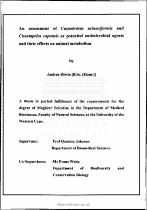| dc.contributor.advisor | Johnson, Quinton | |
| dc.contributor.author | Bowie, Andrea | |
| dc.date.accessioned | 2022-10-10T10:46:37Z | |
| dc.date.available | 2022-10-10T10:46:37Z | |
| dc.date.issued | 2002 | |
| dc.identifier.uri | http://hdl.handle.net/11394/9346 | |
| dc.description | >Magister Scientiae - MSc | en_US |
| dc.description.abstract | The definition of a medicinal plant (as formulated by the WHO) is a plant that consists of either one or more plant parts with therapeutic properties that can be used in the development of drugs (sofowora lg82). Various medicinal plants have been used over the years for their healing properties, and it can even be said that this is an ancient practice (Cowan 1999). Plant derived medicines have been part of traditional healthcare in most parts of the world for thousands of years @alombo & Semble 2001- Salie 1998))' Presently, approximately l|%of the world population make use of plants and its extracts (salie 1998; Abelson 1990). Despite this widespread use of medicinal plants, only a fraction has been tested. Many plant derived natural products must be investigated for their pharmacological activity (Mendelson & Balick 1998; Gentry 1993)' Hence it is of utmost importance to study medicinal plants for safety and efficacy @loff 1998)' since there is still an infinite number that must be studied and discovered (Abelson 1990; Sofowora 1982). Hippocratus in the late fifth century B.C.) was a physician who strongly believed in herbal remedies to treat many ailments and recorded the use of approximately 300 to 400 medicinal plants (cowan 1999; Sofowora 1982; Schultes 1978). It is also believed that the Egyptians (1500 B.C) made use of medicinal plants as some records excavated
from ancient Egyptian tombs stated (Sofowora 1982). The De Materia Medical medicinal plant catalogue of about 600 medicinal plants, was compiled by the Greek Dioscorides (A. D. 60) and was used by Europeans as a standard reference during medieval times (Cowan Lggg,Sofowora lg82). The works of the physician Galen were used in the middle ages but many of his records were destroyed. In spite of these unfortunate circumstances, present allopathic and homeopathic systems have been derived from the works of Galen (Sofowora 1982)' | en_US |
| dc.language.iso | en | en_US |
| dc.publisher | University of the Western Cape | en_US |
| dc.subject | Carpobrotus acinaciformis | en_US |
| dc.subject | Cissampelos capensis | en_US |
| dc.subject | Candida albicans | en_US |
| dc.subject | Myco bacterium smegmatis | en_US |
| dc.subject | Antimicrobial | en_US |
| dc.subject | Phytochemistry | en_US |
| dc.subject | Disc Diffusion | en_US |
| dc.subject | Atomic Absorption Spectrometry (AA) | en_US |
| dc.subject | UV/Visible | en_US |
| dc.subject | SpectroPhotometry | en_US |
| dc.subject | Animal metabolism | en_US |
| dc.title | An assessment of Carpobrotus acinaciformis and Cissampelos capensis as potential antimicrobial agents and their effects on animal metabolism | en_US |
| dc.rights.holder | University of the Western Cape | en_US |

